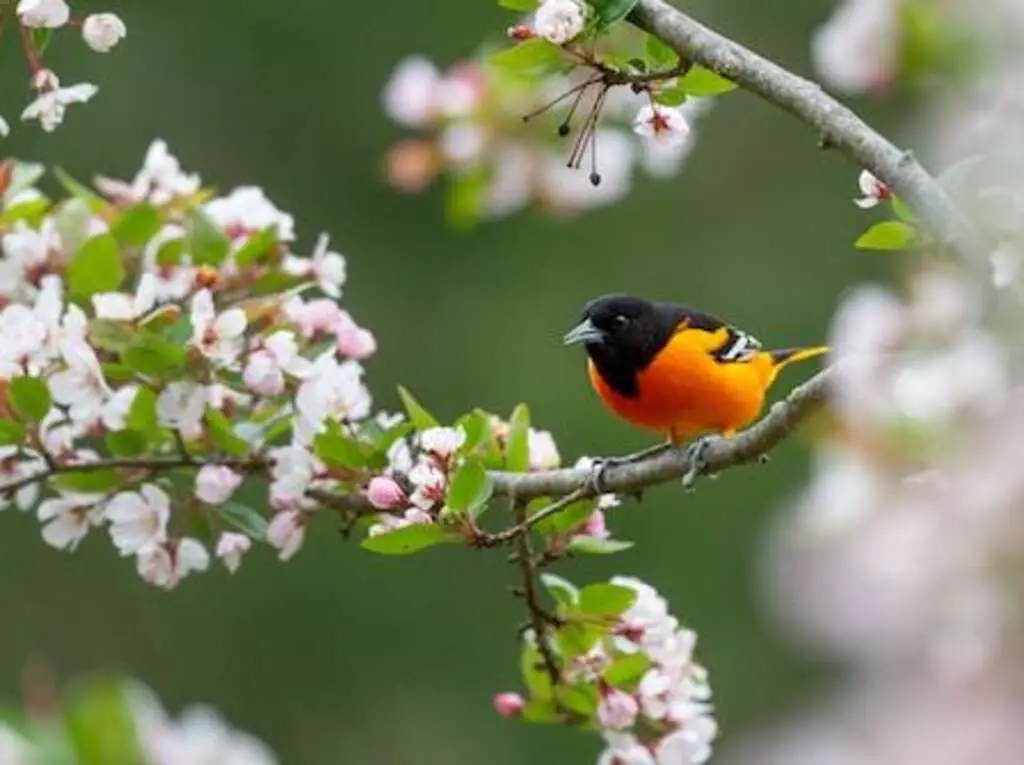“Do Baltimore Orioles Eat Insects?” Forget what you thought you knew about these vibrant birds with their striking orange plumage and melodious songs.
While they grace our backyards in North America during spring and summer, there’s more to their diet than meets the eye.
Join us as we unravel the surprising truth about Baltimore Orioles and their unexpected relationship with insects. Get ready for a delightful twist that will leave you captivated!
Table of Contents [show]
Do Baltimore Orioles Eat Insects?
Yes, Baltimore Orioles do eat insects. While they are primarily known for their consumption of fruit, nectar, and flower blossoms, they also include insects in their diet.
Orioles are considered omnivorous, meaning they consume a variety of foods, including insects, spiders, and other small invertebrates.
Insects often play a significant role in their diet, especially during the breeding season, when they need to provide a high protein diet for their young.
Orioles may forage for insects by gleaning them from leaves and branches or by catching them in mid-air.
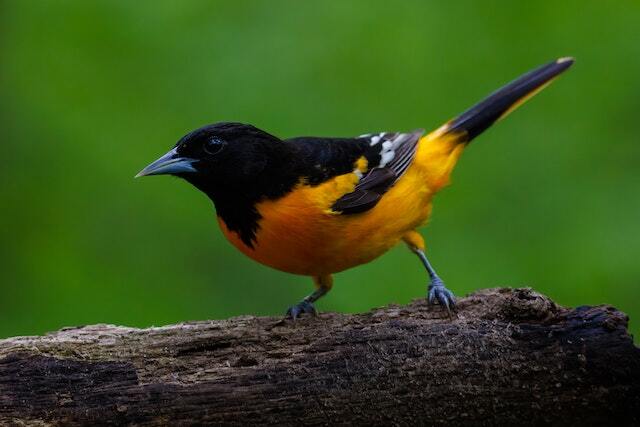
Introduction to Baltimore Orioles and Their Diet
The diet of Baltimore Orioles primarily consists of small invertebrates, such as caterpillars, spiders, and beetles.
Baltimore Oriole’s feeding habits are unique in that they are primarily insectivorous, unlike other bird species that may consume fruits and seeds.
Insects are a vital source of protein for birds, and Baltimore Orioles are no exception.
Insects provide essential nutrients for bird growth and development, making them crucial for the survival of bird populations.
Therefore, it is not surprising that Baltimore Orioles rely heavily on insects as a primary food source.
The importance of insects for bird diets cannot be overstated, and the Baltimore Oriole serves as an excellent example of this reliance.
Insects as a vital source of protein are necessary for the growth and survival of bird populations, and the Baltimore Oriole’s feeding habits demonstrate this fact.
Insects as a Vital Source of Protein
Insects have been identified as a vital source of protein for many bird species, with some studies estimating that up to 90% of bird species rely on insects for their diet.
Insect protein benefits include high nutritional value, easy digestion, and reduced environmental impact when compared to traditional livestock farming.
Sustainable insect consumption has emerged as a potential solution to address the growing demand for protein while minimizing the negative impacts of animal agriculture on the environment.
Additionally, insects have been found to contain beneficial compounds such as antioxidants and antimicrobial peptides, which may have potential health benefits for both birds and humans.
As such, the consumption of insects is an innovative and sustainable solution to address the challenges of feeding a growing population while preserving the environment.
With this in mind, understanding the role of insects in bird diets is crucial, including their importance for migratory species like Baltimore Orioles.
Baltimore Orioles’ Migration Patterns
Understanding the migratory patterns of certain avian species is crucial in determining their dietary needs and identifying potential solutions for addressing the challenges of sustaining their populations.
The Baltimore Oriole is a migratory bird species that breeds in North America during the summer and migrates to Central America during the winter.
These birds primarily feed on insects and fruits during the breeding season. Insects are especially important for the growth and development of their young.
However, climate change has impacted the migratory patterns of Baltimore Orioles, leading to changes in their breeding habits and feeding behavior.
As temperatures rise, Baltimore Orioles are now breeding earlier in the year, which has led to a decline in insect populations.
This shift in the timing of breeding has also impacted the availability of fruits, which they rely on during migration.
To attract Baltimore Orioles to your backyard, it is important to provide them with a diverse array of food sources, including insects, fruits, and nectar.
By doing so, you can help support their populations and ensure their survival.
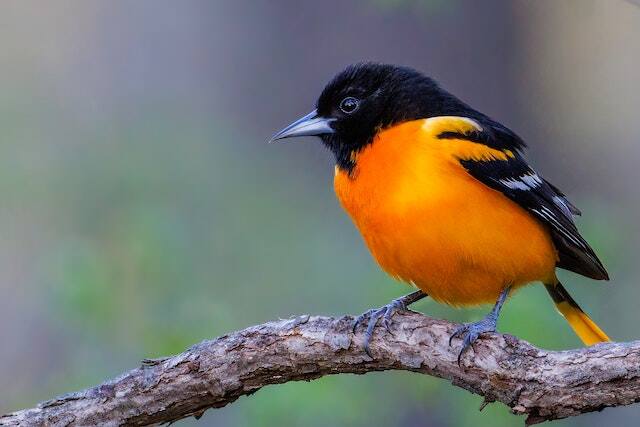
Attracting Baltimore Orioles to Your Backyard
Attracting Baltimore Orioles to your backyard requires creating an insect-friendly habitat as they primarily feed on insects during the breeding season.
Providing a variety of nectar and other foods can also entice these colorful birds to visit your yard.
To attract Baltimore Orioles, it is important to maintain a clean and safe environment, free from pesticides and other harmful chemicals.
Providing Insect-Friendly Habitats
Creating habitats that promote insect populations can benefit a variety of bird species, including Baltimore Orioles.
Insects are a crucial source of food for many bird species, and providing insect-friendly habitats can help sustain a diverse and healthy bird population.
Creating biodiversity in your garden through sustainable gardening practices, such as planting native plants and avoiding the use of pesticides, can encourage insects to thrive.
Incorporating elements such as water sources, bird baths, and brush piles can also attract insects and provide shelter for birds.
By promoting insect populations, you can provide a valuable food source for Baltimore Orioles and other bird species.
Offering nectar and other foods can further enhance the habitat and attract even more birds to your backyard.
Offering Nectar and Other Foods
By incorporating nectar and other food sources into your garden, you can provide an additional food source for a diverse range of bird species, ultimately enhancing the overall habitat and potentially attracting more birds to your backyard.
To offer nectar alternatives, you can plant flowering shrubs and trees such as dogwood, butterfly bush, and honeysuckle. These plants not only provide food but also shelter and nesting sites.
Another way to provide food for birds is by offering bird feeders, which come in a variety of designs such as tube, hopper, and platform feeders.
Different feeders cater to different bird species, so it’s important to research which ones are best for your area and the birds you wish to attract.
In addition to nectar and bird feeders, you can also offer other foods such as fruits, mealworms, and jelly.
By incorporating these various food sources into your garden, you can create a diverse habitat that can attract a range of bird species, including the Baltimore Oriole.
Speaking of which, while nectar is a key component of their diet, it is not the only food they consume. Other foods in their diet include insects, fruits, and even spiders.
Other Foods in Baltimore Orioles’ Diet
The Baltimore Orioles’ diet consists of a variety of foods, including fruits, nectar, and small invertebrates. Baltimore Orioles are known to prefer fruits such as oranges, berries, and grapes.
However, their fruit preferences may vary depending on the availability of fruits in their habitat.
Habitat loss can have a significant impact on Baltimore Orioles’ diet, as it may limit the availability of their preferred fruits.
In addition to fruits, Baltimore Orioles also consume nectar from flowers. They use their long, curved beaks to reach into the flowers and extract the sweet nectar.
Furthermore, small invertebrates such as insects and spiders are also a part of their diet.
Baltimore Orioles use their sharp beaks to catch and eat insects, which provide them with essential nutrients such as protein.
The table below shows some of the insects that are a part of the Baltimore Orioles’ diet. While fruits and nectar are the main components of their diet, the consumption of insects is also vital for their survival.
| Insects | Benefits |
|---|---|
| Caterpillars | High in protein |
| Grasshoppers | High in protein and calcium |
| Spiders | High in protein |
| Beetles | High in protein and fat |
The consumption of insects provides Baltimore Orioles with essential nutrients that are not found in fruits or nectar.
Insects are high in protein, which is necessary for the growth, development, and maintenance of their bodies.
Moreover, some insects are also high in calcium and fat, which are essential for the health of their bones and feathers.
Therefore, Baltimore Orioles consume a variety of foods, including fruits, nectar, and insects, to meet their nutritional needs.
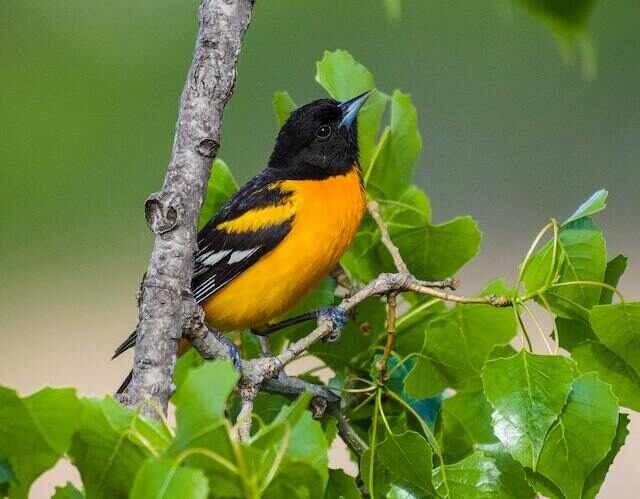
Benefits of Eating Insects
While Baltimore Orioles do eat other foods besides insects, it’s important to note the benefits of including insects in their diet.
Insect cuisine has been gaining popularity in recent years due to its environmental sustainability.
Compared to traditional livestock, insects demand significantly lower quantities of water, land, and feed to generate an equivalent amount of protein.
Additionally, insect production produces fewer greenhouse gas emissions and generates less waste than traditional livestock farming.
Incorporating insects into the Baltimore Oriole’s diet could not only provide them with a diverse and nutritious food source but also contribute to a more sustainable food system.
With this in mind, it’s worth considering the potential benefits of incorporating insects into our own diets as well.
This shift towards more sustainable food sources could have significant positive impacts on both our health and the health of our planet.
Moving forward, it’s important to continue exploring innovative and sustainable ways of feeding ourselves and the wildlife around us.
Conclusion
Insect cuisine’s potential to contribute to a more sustainable food system is a reminder that exploring innovative and resource-efficient ways of feeding ourselves and the wildlife around us is essential for a healthy planet.
The benefits of insect consumption are numerous, from being a source of protein and essential nutrients to requiring fewer resources to rear compared to traditional livestock.
As we face the impact of climate change on our food systems, it’s important to consider the diets of wildlife as well.
For example, the Baltimore oriole, known for its bright orange plumage and sweet song, relies on insects as a primary food source.
As the climate changes, the availability and timing of insect emergence may shift, affecting the orioles’ ability to find food.
Incorporating insects into our own diets could potentially alleviate some of the pressure on insect populations, allowing more to be available for wildlife like the Baltimore oriole.
With this in mind, let’s explore some fun facts about Baltimore orioles and their relationship with insects.
Fun Facts About Baltimore Orioles and Insects
Exploring the relationship between Baltimore orioles and insects reveals intriguing insights into the natural balance of food systems and highlights the delicate interdependence of species within ecosystems.
While Baltimore orioles are primarily known for their love of fruit, they do occasionally eat insects, which make up a small but important part of their diet.
Interestingly, Baltimore Orioles play a key role in pollination, as they feed on nectar and spread pollen from flower to flower.
They also act as insect predators, helping to control populations of pests that can damage crops and other plants.
In addition, Baltimore orioles have been observed using spider silk to weave their nests, highlighting their resourcefulness and adaptability in utilizing different natural materials.
Finally, it is worth noting that the relationship between Baltimore orioles and insects is just one example of the complex and dynamic interactions that occur within ecosystems, reminding us of the intricate web of life that exists all around us.
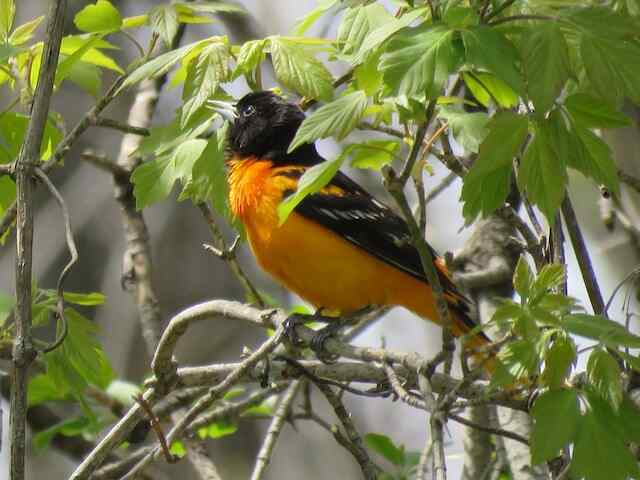
Frequently Asked Questions
How do Baltimore Orioles mate and reproduce?
Baltimore Orioles are known for their beautiful plumage and melodic songs, but their mating behavior and nest building habits are equally fascinating.
The mating behavior of Baltimore Orioles involves the male performing a courtship display, which includes flapping his wings and singing to attract a female.
Once a female is interested, they will mate and the female will build a nest.
Orioles typically build their nests in the branches of trees using a variety of materials including grasses, bark, and spider silk. The female will lay 3-7 eggs and both parents will incubate the eggs.
Once the eggs hatch, both parents will care for the chicks until they are ready to fledge.
Overall, the mating behavior and nest building habits of Baltimore Orioles are important aspects of their life cycle and contribute to their successful reproduction.
What is the lifespan of a Baltimore Oriole?
The Baltimore oriole, a brightly colored songbird, has a lifespan of approximately 7-8 years in the wild.
During this time, they undertake an impressive migration from their breeding grounds in North America to their wintering grounds in Central and South America.
Baltimore orioles are known for their unique nesting habits, constructing intricate pouch-like nests that hang from branches.
These nests are woven together with plant fibers and often decorated with materials such as hair and string.
While their nesting habits and migration patterns are fascinating, it is important to note that the topic of whether or not Baltimore orioles eat insects was not addressed in this paragraph.
How do Baltimore Orioles communicate with each other?
Like a symphony conductor, Baltimore orioles use their vocalizations to communicate with each other in a complex and sophisticated manner.
These birds are known for their beautiful and melodic songs, but they also use a variety of calls and chirps to convey different messages.
For instance, they have a specific call to warn other birds of potential predators, a different call for greeting, and another call for indicating food sources.
Vocalizations are crucial for these birds not only for communication but also for attracting mates.
In addition to vocalizations, Baltimore orioles also communicate through their nest-building behavior. They construct intricate and elaborate nests, which serve as a visual cue for other birds to identify their territory.
Overall, the communication methods of Baltimore orioles are fascinating and highlight the importance of vocalizations and nest building in avian behavior.
What is the history behind the Baltimore Oriole’s name?
The Baltimore Oriole is a well-known bird species that is native to North America. The bird is known for its distinct song and striking appearance, which features a bright orange plumage and black wings.
The name of the bird has a rich history, as it was named after the coat of arms of Lord Baltimore, an English nobleman.
The bird has a unique migration pattern and can be found in the eastern part of North America during the summer months and migrates to Central America and the Caribbean during the winter.
The Baltimore Oriole’s song is known to be a complex series of whistles, trills, and warbles.
The bird is primarily a fruit eater but has also been known to consume insects, especially during the breeding season when they need extra protein for their young.
Overall, the Baltimore Oriole is an interesting and unique bird species that continues to captivate bird enthusiasts and researchers alike.
How do Baltimore Orioles interact with other bird species in their habitat?
Bird interactions and habitat dynamics play a crucial role in the survival of various avian species. For instance, Baltimore Orioles, known for their vibrant plumage, often interact with other bird species in their habitat.
These interactions can be cooperative or competitive, depending on the specific ecological conditions.
One example of cooperative interactions is the nesting association between Orioles and Yellow Warblers. Orioles benefit from the presence of Warblers by reducing the risk of nest predation.
Conversely, Warblers benefit from Orioles by gaining protection from predators and aggressive birds.
However, competition can also arise between Orioles and other bird species, especially when resources such as food and nesting sites are limited.
Understanding the complex dynamics of bird interactions and how they are influenced by various ecological factors is crucial for the conservation of avian species and their habitats.
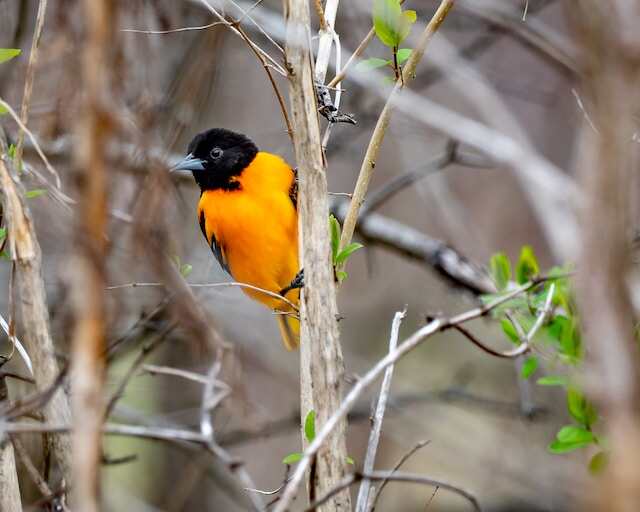
Conclusion
The Baltimore Oriole is a migratory bird that is known for its vibrant orange plumage and melodious songs. Their diet primarily consists of insects, which provide them with a valuable source of protein.
Insects such as caterpillars, beetles, and flies are essential for the survival of Baltimore Orioles, especially during breeding season when they require large amounts of protein for egg production and feeding their young.
Baltimore Orioles are known to migrate over long distances, from their wintering grounds in Central and South America to their breeding grounds in North America. During migration, they rely heavily on insects for sustenance.
In the summer months, Baltimore Orioles can be attracted to backyards by offering them a variety of foods, including fruits, nectar, and jelly.
Eating insects has numerous benefits for both birds and humans. Insects are a rich source of protein and contain essential nutrients like vitamins and minerals.
They are also sustainable and require fewer resources to produce than traditional livestock. However, many people are hesitant to eat insects due to cultural biases.
In conclusion, Baltimore Orioles rely heavily on insects for their survival and migration. By offering them a variety of foods in our backyards, we can help support their populations.
Additionally, embracing insects as a food source could have significant benefits for both human health and the environment.
As the saying goes, “you are what you eat,” and perhaps it’s time for us to start embracing the idea of being insectivores.

